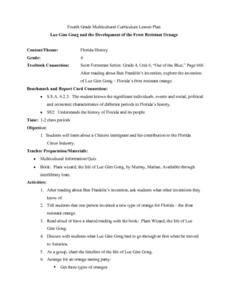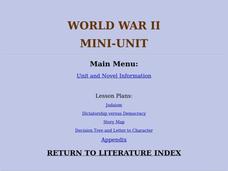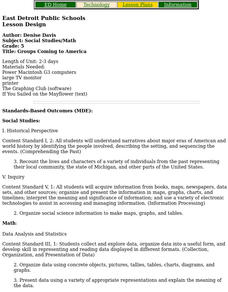Curated OER
Lue Gim Gong and the Development of the Frost Resistant Orange
Fourth graders read about Ben Franklin's invention and talk about other inventions they have heard about. They listen to the book about Lue Gim Gong and discuss what he had to go through at first when he came to America and chart the...
National First Ladies' Library
World Starvation
Students investigate the concept of world starvation and some of the organizations that are founded in order to help solve the problem. They conduct research using a variety of resources. The information is used in order to conduct class...
Curated OER
Seasoning the School Year
Students observe the changes a class tree goes through as the seasons change and record observations in journals. They investigate changes in the weather, changes in the length of the day, and how that affects people. They create...
Curated OER
Women's History Week
Students investigate the contributions of women who influenced human rights in US history. They examine the influence Susan B. Anthony, Harriet Tubman, Sojourner Truth and Elizabeth Cady Stanton by participating in a jigsaw activity....
Curated OER
Animals Matter
Learners explore philanthropy. In this character education lesson, students define and give examples of philanthropy. Learners listen to the story A Symphony of Whales and describe how the characters helped the whales. Students discuss...
Curated OER
Gingerbread Baby v. Gingerbread Boy #7
Students read two stories. In this comparison lesson, students read "The Gingerbread Baby," by Jan Brett and the original "Gingerbread Boy." Students use a Venn Diagram to compare and contrast the two stories.
Curated OER
Westward Expansion
Students locate California and New York on a map and explore available means of travel in the 19th century. Students explore the role of trade in pioneer America and simulate various barter transactions.
Curated OER
Nutrition: Gregory the Terrible Eater
Young scholars listen to a story about a goat who craves human food. They discover the four basic food groups and discuss what they might eat if they were terrible eaters. Students retell the story by looking at the pictures. They...
Curated OER
Seasons
First graders investigate the four seasons of the year. For this seasons lesson, 1st graders identify the correct order of seasons, discover different climates, and examine how to dress appropriately for each season.
Curated OER
Judaism
Students brainstorm what they know about Judaism, participate in question and answer session about Judaism and its relation to World War II with guest speaker of Jewish faith, and write journal responses about their feelings on...
Curated OER
Groups Coming to America
Fifth graders use text or other references to locate different types of information about the Mayflower and pilgrims. They create a presentation for lower elementary classes about the Pilgrims.
Curated OER
Number Cents
Students identify the value of coins. In this number cents lesson, students use coins to create sets of equivalent values. They create patterns with coins and write the value of coins in two forms. Students count the value of given coins.
Curated OER
A World of Taste--Louisiana Gumbo
Students discover the multicultural contributions to New Orleans gumbo through participation in cross curriculum activities. In this multicultural diversity and New Orleans history lesson, students shade regions of a map according to a...
Curated OER
History in the Making: The Tortilla
Fourth graders examine the history of the tortilla and extend the study across the curriculum. In this history of the tortilla lesson, 4th graders research the background of the tortilla, determine the ingredients, and work with the...
Curated OER
Westward Expansion
Students explore the Westward Expansion Movement of U.S. history. In this Westward movement lesson, students use primary and secondary source documents research personal accounts of those who travelled west during the era....
Curated OER
Sacred Places: California Missions from Different Perspectives
Students create a project poster displaying photos, drawings, and journal writings that incorporate the major themes of California's missions, and use perspective and point of view both visually and in writing.
Curated OER
Putting a Spin on Current Events
Students examine the symbolism on a 17th-century cabinet. In this symbolism instructional activity, students view samples of a 17th century cabinet and identify it's symbols. Students create their own cabinet by using various art...
Curated OER
Figure of Speech
Examine the changing nature of language in the U.S. View and discuss excerpts from a PBS documentary with your class and then conduct Internet research, and complete a team project on the evolution of teen expressions.
Curated OER
Insurance Quotes
You're in high school and you just got the coolest car ever! But, now you need to start thinking about car insurance. Luckily, your teacher prepared you by engaging you in a life skills lesson like this one. The class actually calls...
Curated OER
Alfonso Ball
Joey Alphonso made up this game, which is played using a gator skin ball and a tennis racket on a basketball court. The simple rules and strategy of the game are explained. This is a high-scoring, run around activity. Everyone can...
Curated OER
The Journey of Sacagawea
Students examine the life of Sacagawea, the exceptional woman chosen to appear on the Golden Dollar, and write journal entries based on their research.
Curated OER
Feelings On Japanese Internment
Students listen to the story, "The Bracelet" and evaluate with other class members right and wrong actions. They create a watercolor painting that describes how the book made them feel and discuss their feelings with the rest of the class.
Curated OER
How Does a Friend Act?
Students brainstorm a list of characteristics that friends should and should not have. In groups, they are given a set of hand puppets in which they role-play different scenerios in front of the class. To end the lesson, they are shown...
Curated OER
A Picture is Worth a Thousand Words
Pupils create various types of graphs. They go to suggested websites to collect data and create graphs to organize the data. Then they answer questions according to their graph.

























